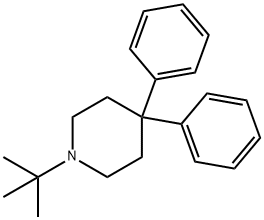Parkinsan was launched in Germany as a centrally-active anti-Parkinsonian
agent. It can be prepared in three steps: a Mannich-aldol sequence to assemble the
4-phenylpiperidine scaffold followed by a Friedel-Crafts reaction to introduce the
second phenyl ring. Parkinsan is effective for the treatment of Parkinsonian tremors
and is similar in action to, but more potent than, biperiden. It exhibits use-dependent,
open channel, uncompetitive NMDA receptor antagonistic activity. This may occur by
binding to the PCP site in addition to interacting with sigma, binding sites in the frontal
cortex. Parkinsan is also an antagonist at presynaptic muscarinic autoreceptors but
facilitation of direct or indirect dopaminergic transmission does not contribute to its
actions. While its mechanism of action is not completely understood, it has a weak
inhibitory effect on dopamine reuptake, inhibits evoked GABA release (with low affinity
for GABA-A receptors and a lower affinity for benzodiazepine receptors), and has a
weak inhibitory effect on MAO-B.




